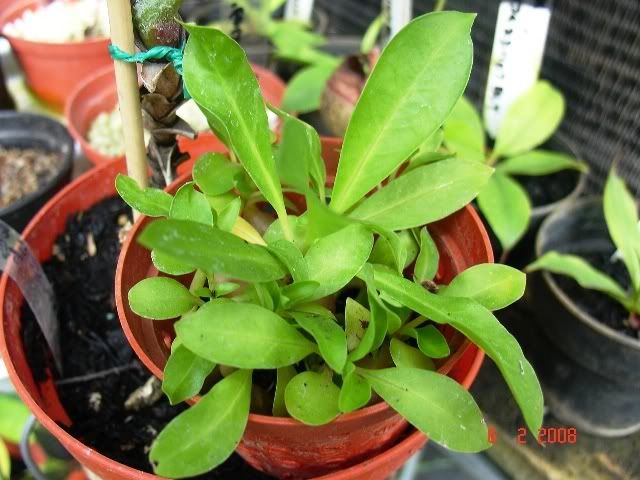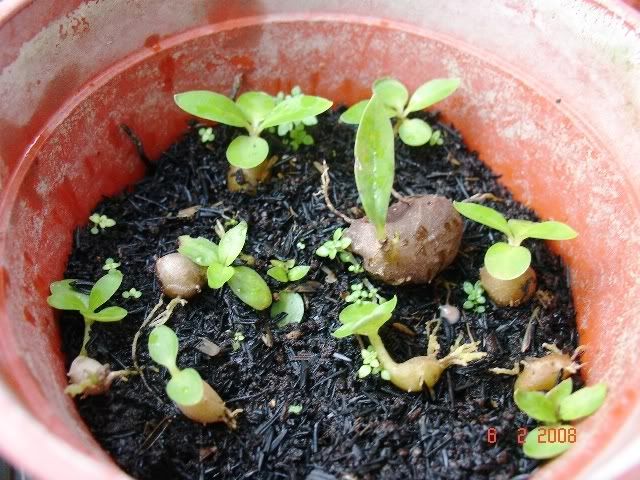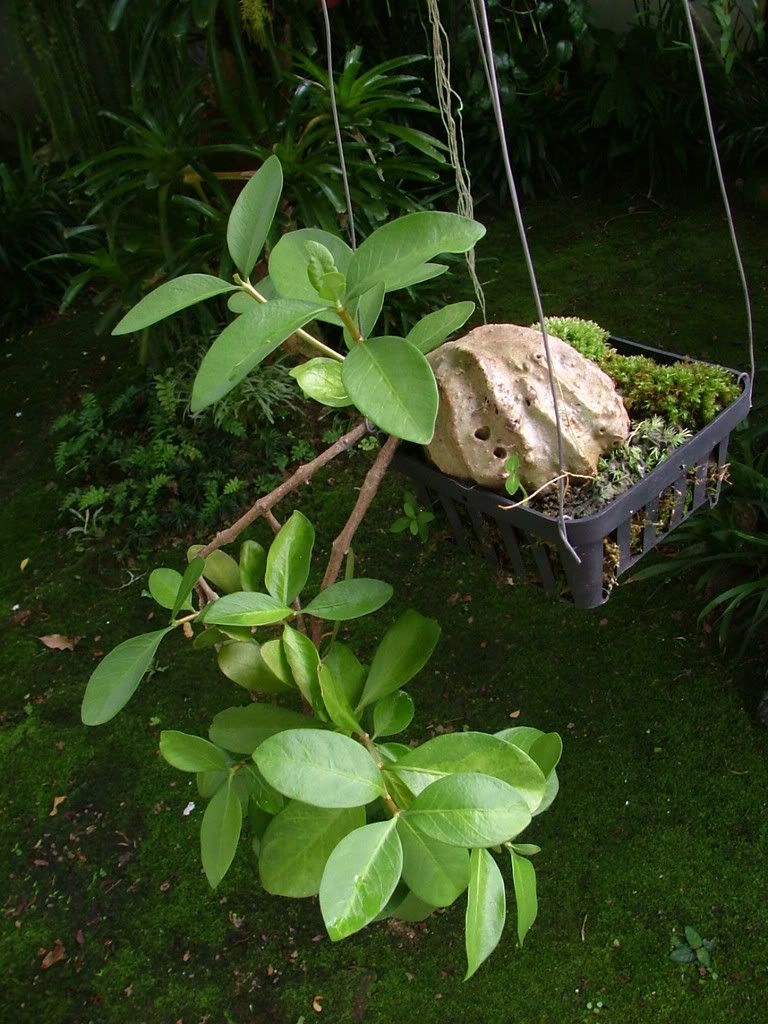|
|
Post by David on Jan 27, 2008 23:00:20 GMT 8
Since my trip with Choong to see Nepenthes, I've been wanting to get my hands on ant plants. They look so weird and unique. Would love to start growing them. Anybody knows where to get them, or if you have extra to sell me? ;D This is what got me thinking about them...  Such a beauty! I just love weird and unique stuff! |
|
|
|
Post by atmccmn on Jan 27, 2008 23:18:15 GMT 8
David,
Those are Dischidia imbricata with Dischidia rhombifolia at the back I think. You can easily get Dischidia pectinoides or Dischidia major at your local nurseries easily.
Dischidia imricata needs the assistance of ants to thrive well. There are other group of plants which also play as host to ants too. All are generally called ant plants.
Hope this helps.
Cheers,
AT
|
|
|
|
Post by David on Jan 27, 2008 23:55:42 GMT 8
Ok, will check out sg. buloh. I guess they all should look similar.
|
|
|
|
Post by phissionkorps on Jan 28, 2008 7:55:17 GMT 8
Myrmecodia should also be easy to find in Malaysia. You could look on ebay too...maybe grow from seed (if you have everlasting patience). Lecanopteris looks even more strange: brutalablommor.se/pix/pumila3.jpgInteresting fact: 2 prominent biologists had a long running debate about the ant/plant relationship. One saw it as a mutualism, while another (E.O. Wilson maybe??) saw it as a parasitism. |
|
|
|
Post by David on Jan 28, 2008 9:55:32 GMT 8
Wow! That's a beauty! I like Lecanopteris too. What a cool plant! Does it take a long time for the seeds to germinate and grow to adult plants? Looks like it from the way you discribe it phissionkorps. I'll look for adult plants in the nursery.
One question tho'. If there are no ant nest in the plants, can I suppliment with fertilisers? Will the plants die if there are no ants?
|
|
|
|
Post by phissionkorps on Jan 28, 2008 10:23:04 GMT 8
To my knowledge, all caudiform plants take an "eternity" to grow. I think from seed to anywhere near the size of a US silver dollar*, you're probably looking at a couple years (2 or 3?). I don't grow it, so I can't tell you for sure. I would think you can supplement with fertilizers. I think there are a couple of species which must have ants in them, or else they will do awful and/or die, but I couldn't tell you which ones. Is "twoton" a member on this forum? I don't think so, but he's on pitcherplants, so you could ask him there, or here is his website: www.two-ton.com/. He grows (or grew) a couple ant plants in Taiwan, including Lecanopteris. *Since those aren't in circulation anymore, if you don't know big that is, touch your pointer finger to the knuckle on your thumb thats closest to your thumbnail. It's a bit smaller than that. |
|
|
|
Post by atmccmn on Jan 28, 2008 18:23:37 GMT 8
I think there are only 2 known species of lecanopteris you can find locally. Forget about Lecanopteris crustacea. It only thrive well in cool temperatures. Go for our lowland L. sinousa ( I think my spelling is correct! ;D)
You also can try for hydnophytum (hydnophytum formicarum). They are pretty hardy and fuss free not like it's other cousin.....mymercodia.
These are speciallised plants which means they had adapted themselves to grow without soil. You have to understand their culture first before attempting to grow any of them.
Dischidia is the easiest among all. Fuss free.
Cheers,
AT
|
|
|
|
Post by David on Jan 29, 2008 14:20:20 GMT 8
Ok, thanks. I'll need to look up google/yahoo for a picture of these plants and try to look for them. So sinousa, hydnophytom and dischidia. Ok, got it.
|
|
|
|
Post by phissionkorps on Jan 29, 2008 17:20:53 GMT 8
|
|
|
|
Post by atmccmn on Jan 29, 2008 21:30:55 GMT 8
Do agree. Respond very well to fertiliser too.
|
|
|
|
Post by rainforestguy on Feb 4, 2008 4:05:38 GMT 8
Hydnos and Myreme's aren't difficult to grow and grow quickly if grown with monsoon climates in mind. This means a wet, heavy fertilization period and then a dry spell. It is during their dry spell that they do the caudex development. they produce seeds easily and non-stop. Seeds germinate readily and easily in moist peatmoss. There have been many new species of each plus a few new genus including an ant impatiens with beautiful orchid-like flowers.
Dischidias like it drier while ant hoyas like it wetter. H. darwinii, imbricata, etc likes their soil wet while dischidias such as melanesica, imbricata, major, vidalii, etc, all prefer bright light and more air circulation. D vidalii produces seeds without pollination and this is easier to grow than cuttings.
M
|
|
wijaya
Junior Member
  Pride of Sumatra
Pride of Sumatra
Posts: 54
|
Post by wijaya on Feb 11, 2008 21:17:46 GMT 8
Is this Ant Plant as well? Any idea what species are they?  And  These are grown from seeds, the mother plants already rotted. Thanks, Ed |
|
|
|
Post by David on Feb 12, 2008 12:12:16 GMT 8
Thanks pissionkorps for the link and rainforestguy for the additional information.
Hey wijaya, I think I saw something like what you posted in a nursery before and they tag it as ant plant. don't know if yours is that species of ant plant. It's kinda cute too. Haa, haa, like potatoes with limbs. Really cute.
|
|
|
|
Post by sockhom on Feb 12, 2008 16:53:24 GMT 8
Isn't that Myrmecodia echinata?
François.
|
|
wijaya
Junior Member
  Pride of Sumatra
Pride of Sumatra
Posts: 54
|
Post by wijaya on Feb 12, 2008 22:03:20 GMT 8
Yes, I think it is Myrmecodia but not sure what variants.
@david, they very cute like you said. But easily rotted as well if get too wet.
Ed
|
|
kk
Junior Member
 
Posts: 78
|
Post by kk on Feb 13, 2008 10:51:36 GMT 8
|
|
|
|
Post by phissionkorps on Mar 6, 2008 8:35:48 GMT 8
I ordered a Hydnophytum formicarium last night  Will post pics when it gets here. I'd like to get a Lecanopteris but I have to either keep checking eBay or order from Wistuba... |
|
|
|
Post by phissionkorps on Mar 11, 2008 16:30:04 GMT 8
 The caudex is under the curved stem. It's an oblong kinda smooth brownish thing. When I first got it, I tapped on the caudex and it made a cool hollow sound  . I can't wait until the caudex gets big and the plant is impressive. |
|
|
|
Post by atmccmn on Mar 11, 2008 21:19:32 GMT 8
Congrats you on your purchase. It sure to rewards you in future. I'm sure you know how to take care of it. Tough like a tank! Here's a picture of how your plant will look like in future (   )  |
|
|
|
Post by phissionkorps on Mar 12, 2008 11:13:57 GMT 8
very nice.
Any pointers for me?
|
|